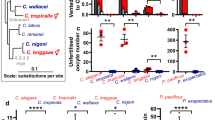Summary
A comparison of two genetic stocks ofCampanularia flexuosa revealed consistent differences with respect to (1) the number of eggs present in the maturefemale reproductive body (gonangium), (2) the level on each upright stem at which the first gonangium forms, and (3) their preference for the formation of reproductive versusvegetative (side-branch) structures.
Alterations in food intake established the optimum feeding level for maximal production of structurally normal gonangia and also showed differences between stocks in the effects of reduced food intake on gonangial versus vegetative growth.
A staging series for gonangiogenesis was developed from observations of filling of the gonangium with primordial egg cells (PEC), gonangial elongation, funnel maturation and oogenesis.
When upright segments bearing immature gonangia are isolated from the stolon the gonangia frequently resorb, transform into vegetative outgrowths, or form structurally abnormal gonangia bearing fewer germ cells than normal. These responses, and the observed accumulation of PEC at sites of presumptive gonangial outgrowth, support a stolonic origin hypothesis for PEC and implicate PEC and oocytes in the initiation, maintenance and maturation of structurally normal gonangia. In addition, continued differentiation of the gonangial structure appears to be necessary for oocyte maturation.
Possible mechanisms for somatic and gametic cell recruitment, and the theoretical importance of cellular proliferation, aging, cell-shape changes, cell movement and cellular interactions in normal gonangial differentiation are discussed.
Similar content being viewed by others
References
Allman, G. J.: Report on the present state of our knowledge of the reproductive system in the Hydroida. Rep. 33rd Meet. Brit. Ass. Adv. Sci. 351–426 (1863).
Beloussov, L. V., Badenko, L. A., Katchurin, A. L., Kurilo (Filatcheva) L. F.: Cell movements in morphogenesis of hydroid polypes. J. Embryol. exp. Morph.27, 317–337 (1972).
Beloussov, L. V., Dorfman, J. G.: On the mechanics of growth and morphogenesis in hydroid polyps. Amer. Zool.14, 719–734 (1974).
Brock, M. A.: Ultrastructural studies on the life cycle of a short-lived metazoan,Campanularia flexuosa. II. Structure of the old adult. J. Ultrastruct. Res.32, 118–141 (1970).
Burnett, A. L.: The acquisition, maintenance, and lability of the differentiated state inHydra. In: The stability of the differentiated state (H. Ursprung, ed.), p. 109–127. Berlin-Heidelberg-New York: Springer 1968.
Crowell, S.: The regression-replacement cycle of hydranths ofObelia andCampanularia. Physiol. Zool.26, 319–327 (1953).
Crowell, S.: Differential responses of growth zones to nutritive level, age and temperature in the colonial hydroidCampanularia. J. Exp. Zool.134, 63–90 (1957).
Dantschakoff, V.: Keimzelle und Gonade. IIb, Ganzheit des Gewebekomplexes als Faktor in der Entwicklung der Gonade. Z. Zellforsch.15, 581–644 (1932).
Fraipont, J.: Recherches sur l'organisation histologique et le développement de laCampanularia angulata. Arch. Zool. exp. gén.8, 433–466 (1879–1880).
Franchi, L. L., Mandl, A. M., Zuckerman, S.: The development of the ovary and the process of oogenesis. In: The ovary, vol. 1 (S. Zuckerman, ed.), p. 1–88. New York, N. Y.: Academic Press 1962.
Gustafson, T., and Wolpert, L.: The cellular basis of morphogenesis and sea urchin development. Int. Rev. Cytol.15, 139–214 (1963).
Hale, L. J.: Cell movements, cell division and growth in the hydroidClytia johnstoin. J. Embryol. exp. Morph.12, 517–538 (1964).
Hale, L. J.: The pattern of growth ofClytia johnstoni. J. Embryol. exp. Morph.29, 283–309 (1973).
Hargitt, G. T.: Germ cells of coelenterates. I.Campanularia flexuosa. J. Morph.24, 383–419 (1913).
Hargitt, G. T.: Germ cells of coelenterates. II.Clava leptostyla. J. Morph.27, 85–97 (1916).
Hargitt, G. T.: Germ cells of coelenterates. III.Aglantha digitalis. IV. Hybocodon prolifer. J. Morph.28, 593–641 (1917).
Hargitt, G. T.: Germ cells of coelenterates. V.Eudendrium ramosum. J. Morph.31, 1–23 (1917).
Hauschka, T.: The role of hydroplasmic pressure in hydroid growth. Growth8, 321–336 (1944).
Humphrey, R. R.: The developmental potencies of the intermediate mesoderm ofAmblystoma when transplanted into ventrolateral sites in other embryos: the primordial germ cells of such grafts and their role in the development of a gonad. Anat. Rec.40, 67–101 (1928).
Knight, D. P.: Scleratization of the perisarc of the calyptoblastic hydroid,Laomedea flexuosa. I. The identification and localization of dopamine in the hydroid. Tissue and Cell2, 467–477 (1970).
Knight, D. P.: Scleratization of the perisarc of the calyptoblastic hydroid,Laomedea flexuosa. II. Histochemical demonstration of phenol oxidase and attempted demonstration of peroxidase. Tissue and Cell3, 57–64 (1971).
Miller, R. L.: Preliminary observations on maturation of the female gonangium ofCampanularia flexuosa. Biol. Bull.137, 409–410 (1969).
Suddith, R. L.: Cell proliferation in the terminal regions of the internodes and stolons of the colonial hydroidCampanularia flexuosa. Amer. Zool.14, 745–756 (1974).
Trinkaus, J. P.: The cellular basis ofFundulus epiboly. Adhesivity of blastula and gastrula cells in culture. Develop. Biol.7, 513–532 (1963).
Trinkaus, J.: Mechanismus of morphogenetic movements. In: Organogenesis (R. L. Dehaan and H. Unsprung, eds.), p. 55–104. New York, N. Y.: Holt, Rinehart and Winston 1965.
Tucker, G. S.: Dynamic factors in the differentiation of reproductive bodies in the colonial hydroidCampanularia flexuosa (Hincks). Ph. D. Thesis, University of Kansas, Lawrence, Kansas, 133 pp. (1973).
Tucker, G. S.: Observations on oogenesis and vitellogenesis in the colonial hydroidCampanularia fletuosa. (In preparation).
de Varenne, A.: Recherches sur les polypes hydraires (réproduction et développement). Arch. Zool. exp. gén.10, 611–710 (1882).
Weismann, A.: Die Entstehung des Sexualzellen bei den Hydromedusen. Des Baues und der Lebenserscheinungen dieser Gruppe. 295 pp. Jena: Gustav Fischer 1883.
Willier, B. H.: Sterile gonads and the problem of the origin of germ cells in the chick embryo. In: Colloque sur la Différenciation Sexuelle chez les Vertébres, p. 87–91. Paris: Centre National de la Recherche Scientifique 1951.
Wyttenbach, C. R.: The dynamics of stolon elongation in the hydroid,Campanularia flexuosa. J. exp. Zool.167, 333–351 (1968).
Wyttenbach, C. R.: Genetic variations in the mode of stolon growth in the hydroid,Campanularia flexuosa. Biol. Bull.137, 547–556 (1969).
Wyttenbach, C. R.: Cell movements associated with terminal growth in colonial hydroids. Amer. Zool.14, 699–718 (1974).
Author information
Authors and Affiliations
Rights and permissions
About this article
Cite this article
Tucker, G.S., Wyttenbach, C.R. Differentiation of the female reproductive body in the colonial hydroidCampanularia flexuosa . Wilhelm Roux' Archiv 177, 163–181 (1975). https://doi.org/10.1007/BF00848078
Received:
Accepted:
Issue Date:
DOI: https://doi.org/10.1007/BF00848078




